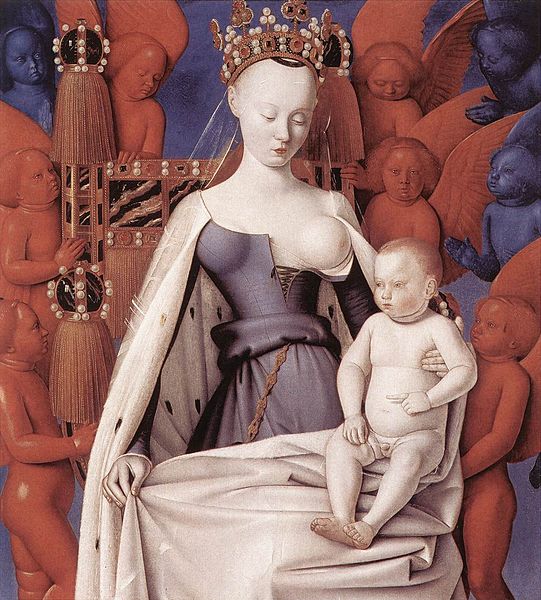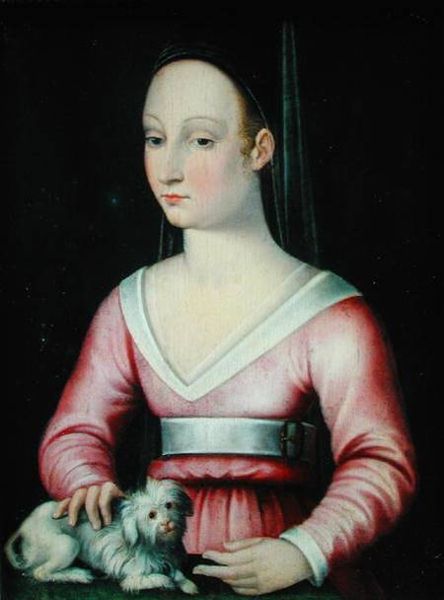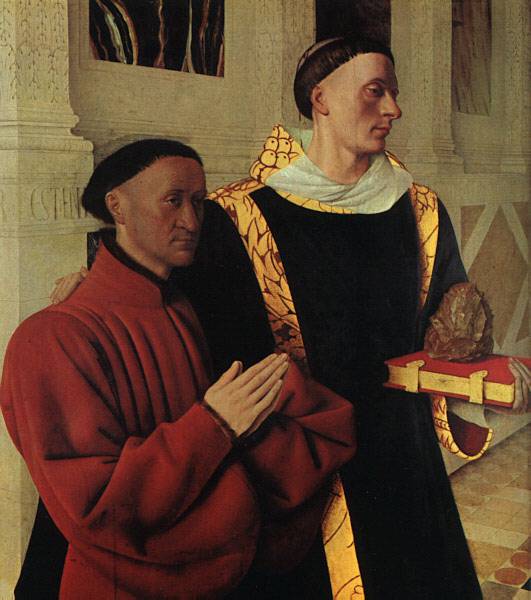Love Goddess #5: Agnes ‘Madonna’ Sorel January 12, 2013
Author: Beach Combing | in : Medieval , trackbackJean Fouquet was the greatest French painter of the fifteenth century. He is of special interest in this blog because JF created the fifth love goddess in our series: the notorious, terrifying Madonna from the Melun Diptych, c. 1450. Thanks to Invisible for the tip.
Let’s start by remembering that madonnas were everywhere in the Middle Ages. Indeed, if you were an artist you basically had a choice between crucifixion, nativity, annunciation or a portrait of ‘some woman’ cast as the Mother of God. Hemmed in by tradition and by their patrons’ usually conservative tastes artists began to play around with techniques and conventions to bring something new to threadbare scenes.
JF certainly did his best here to recast the gentle Madonna found in most medieval works of arts. The unfriendly white skin, the terrifyingly symmetrical globular breasts, the not very maternal look downwards – is she even staring at her child? The hands, one holding (just), the other like a pincer. The resemblance between the dress and modern S&M gear is coincidental, but it is still unsettling. The wallpaper angels behind her that might as well be demons: note the red. In short this is NOT a Madonna you would want to run into on a cold dark night in an alley where the kids have smashed the street lights; or at least you’d be scrambling for your mace if you did bump into her.
It has long been suggested that this Madonna was modelled on Agnes Sorel (obit 1450), mistress to the French King, Charles VII. Nor is this a wild guess. On the back of the diptych is a short passage noting that Etienne Chevalier the owner of the diptych and one time French ambassador had been asked by Agnes to commission the painting on her death bed. In fact, Agnes’ alabaster skin might recall her death: Beach was reminded of the dead Giuliano Medici in Botticelli’s work. The Madonna also looks like Agnes as we know her from other paintings (see above).
Agnes Sorel was an important figure at court: she gave Charles three children and may have been important enough to have been poisoned. One book about her is entitled Agnes Sorel: The Breast And Crotch That Changed History which is one way of reducing a royal mistress’ life to seven words. If you wanted to write a novel you might suggest that Etienne and Agnes had once been an item. It is certainly striking that in the original diptych he looked out from the panel on the left (below). Did JF put in his own disquiet in the person of Etienne’s patron St Stephen who is holding the Bible and seems to say with his expression: ‘Good God! What have I walked into here?’
Any other love goddesses? drbeachcombing AT yahoo DOT com
***
22 Jan 2013: Invisible writes “notorious, terrifying Madonna”… “this is NOT a Madonna you would want to run into on a cold dark night in an alley where the kids have smashed the street lights; or at least you’d be scrambling for your mace if you did bump into her.” Don’t sugar-coat it, Dr B., tell us how you really feel…. But I will say that I’ve always found her shaved forehead to be completely alien-creepy. You mention the red demon-angels. They are actually cherubim. The blue ones are seraphim. You’ll find these tinted angels in other late medieval artworks, like this one: No sinister intent. And the very bejeweled throne may (in addition to the Queen of Heaven/Royal mistress themes) be a reference to Thrones (as in Thrones, Powers, and Dominions). I’m not that worried about the “pincer” hand–the pose indicates that she is presenting the Christ Child to Etienne Chevalier and his patron St. Stephen, in the other panel of the diptych. One oddity is that aristocratic ladies at this time relied on wet-nurses so you’ve got an interesting play of “well, the Virgin nursed the baby Jesus” vs “the Virgin is actually the King’s mistress and she is too refined to nurse her own babies” Another French King’s mistress–Diane de Poitiers, in her bath, looking virginal, while a wet-nurse suckles her child. Then AB “The resemblance between the dress and modern S&M gear is coincidental”. Is it? “is she even staring at her child?” Forgive me if I’m teaching you to suck eggs Beach but she’s staring I suggest at the baby’s finger an artistic device pointing out the Bible with a rock atop it [which in turn may allude to ‘stuff’]. And speaking as an artist the key to the diptych [on so many levels] seems to be precisely the rock/Bible leitmotif which’s seemingly corresponds to 1) boob/Mary’s body 2) baby/sheet [the folds of which I suggest alludes to the mother’s genitalia as well as Jesus’ death shroud] 3) Etienne Chevalier/Saint Stephen and 4) Agnes Sorel/Etienne Chevalier. The rock [shaped like the Pontiff’s ‘fish head’ crown which in turn appears identical to the ‘fish head’ crown worn by the Sumerian high priests of Oannes/Jonah] alludes to the means by which Saul [prior to becoming Paul] had Stephen put to death but it also apparently alludes to the stone placed before Jesus’ tomb. In short rock and Bible = stone and cave. [Cutting out the esoteric stuff apparently going on in there other than pointing out the triple aspected totem pole of i) baby surmounted by ii) angel looking at us surmounted by iii) angel looking downward and noting the curious synchronicity the angels’re red and blue much like their equivalents in Tibetan Buddhism (almost as if they’re a universal experience) etc] my reading of one of Fouquet’s more mundane and disapproving messages with regard to Etienne Chevalier [and his symbolically gated hands] is he was a kind of human chastity belt imposed on Agnes Sorel who Fouquet seems to believe never had the audacity to get her to put him on. Thanks Invisible and AB!!!!!!!





